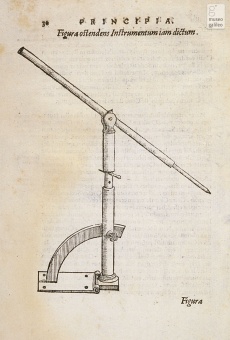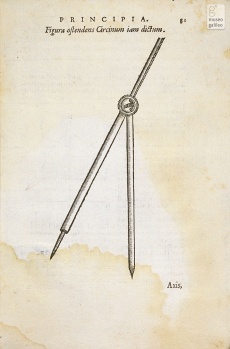Perfect Compasses
From Inventions
| (3 intermediate revisions not shown) | |||
| Line 1: | Line 1: | ||
{{Template invention | {{Template invention | ||
| - | |nome= Name currently used as translation of the Arab ''al-Birkàr'' (compass) ''al- | + | |nome= Name currently used as translation of the Arab ''al-Birkàr'' (compass) ''al-Tam'' (complete, perfect). |
| Line 8: | Line 8: | ||
|data= X century | |data= X century | ||
| - | |descrizione= Compass used for drawing continuous conic sections (ellipses, hyperbolas, and parabolas) developed by Arab mathematicians around the ninth century and described in a specific treatise by Abu Sahl Waijan ibn Rustam al-Quhi (c. 940 - c. 1000) and Mohammed Ibn el Hossein (12th c.). The instrument was composed of two unequal legs, one fixed, the other variable. The variable leg was adjusted in relation to the inclination of the cone’s axis (fixed leg of the compass) in respect to the sheet of drawing paper. In the Renaissance it was known as “oval compass, or compass for drawing ovals” ([[elliptical | + | |descrizione= Compass used for drawing continuous conic sections (ellipses, hyperbolas, and parabolas) developed by Arab mathematicians around the ninth century and described in a specific treatise by Abu Sahl Waijan ibn Rustam al-Quhi (c. 940 - c. 1000) and Mohammed Ibn el Hossein (12th c.). The instrument was composed of two unequal legs, one fixed, the other variable. The variable leg was adjusted in relation to the inclination of the cone’s axis (fixed leg of the compass) in respect to the sheet of drawing paper. In the Renaissance it was known as “oval compass, or compass for drawing ovals” ([[Elliptical Compasses |elliptical compasses]]) and several variants were designed by the leading mathematicians of the time. |
|componenti= | |componenti= | ||
| - | |riferimentibibliografici= Muhammad ‘Abd Allah Ibn al-Hassär, e Ibn Yünus, ''Risãlah al-Birkàr al-Tamam'' | + | |riferimentibibliografici= Muhammad ‘Abd Allah Ibn al-Hassär, e Ibn Yünus, ''Risãlah al-Birkàr al-Tamam''.<br /> |
Barozzi, Francesco, ''Admirandum illud geometricum problema tredecim modis demonstratum : quod docet duas lineas in eodem plano designare, quae nunquam inuicem coincidant, etiam si in infinitum protrahantur & quantò longiùs producuntur, tantò sibiinuicem propiores euadant / Francisco Barocio ... autore ; accessit etiam instrumentum quoddam olim ab eodem autore inuentum, quo cuiuslibet coni ortus ac trium conicarum sectionum in plano descriptio fit ; cum indice locupletissimo eorum quae toto opere continentur'', Venetiis, apud Gratiosum Perchacinum, 1586, pp. 30-31.<br /> | Barozzi, Francesco, ''Admirandum illud geometricum problema tredecim modis demonstratum : quod docet duas lineas in eodem plano designare, quae nunquam inuicem coincidant, etiam si in infinitum protrahantur & quantò longiùs producuntur, tantò sibiinuicem propiores euadant / Francisco Barocio ... autore ; accessit etiam instrumentum quoddam olim ab eodem autore inuentum, quo cuiuslibet coni ortus ac trium conicarum sectionum in plano descriptio fit ; cum indice locupletissimo eorum quae toto opere continentur'', Venetiis, apud Gratiosum Perchacinum, 1586, pp. 30-31.<br /> | ||
Benedetti, Giovanni Battista, ''Io. Baptistae Benedicti ... De gnomonum vmbrarumq[ue] solarium vsu liber ... : nunc primùm publicae vtilitati studiosorumq[ue] commoditati in lucem aeditus'', Augustae Taurinorum, apud haeredes Nicolai Beuilaquae, 1574, pp. 115.117.<br /> | Benedetti, Giovanni Battista, ''Io. Baptistae Benedicti ... De gnomonum vmbrarumq[ue] solarium vsu liber ... : nunc primùm publicae vtilitati studiosorumq[ue] commoditati in lucem aeditus'', Augustae Taurinorum, apud haeredes Nicolai Beuilaquae, 1574, pp. 115.117.<br /> | ||
Current revision as of 13:14, 29 November 2010
Name currently used as translation of the Arab al-Birkàr (compass) al-Tam (complete, perfect).
Contents |
Inventor
arab mathematician
Historic Period
X century
Description
Compass used for drawing continuous conic sections (ellipses, hyperbolas, and parabolas) developed by Arab mathematicians around the ninth century and described in a specific treatise by Abu Sahl Waijan ibn Rustam al-Quhi (c. 940 - c. 1000) and Mohammed Ibn el Hossein (12th c.). The instrument was composed of two unequal legs, one fixed, the other variable. The variable leg was adjusted in relation to the inclination of the cone’s axis (fixed leg of the compass) in respect to the sheet of drawing paper. In the Renaissance it was known as “oval compass, or compass for drawing ovals” (elliptical compasses) and several variants were designed by the leading mathematicians of the time.
Bibliographical Resources
Muhammad ‘Abd Allah Ibn al-Hassär, e Ibn Yünus, Risãlah al-Birkàr al-Tamam.
Barozzi, Francesco, Admirandum illud geometricum problema tredecim modis demonstratum : quod docet duas lineas in eodem plano designare, quae nunquam inuicem coincidant, etiam si in infinitum protrahantur & quantò longiùs producuntur, tantò sibiinuicem propiores euadant / Francisco Barocio ... autore ; accessit etiam instrumentum quoddam olim ab eodem autore inuentum, quo cuiuslibet coni ortus ac trium conicarum sectionum in plano descriptio fit ; cum indice locupletissimo eorum quae toto opere continentur, Venetiis, apud Gratiosum Perchacinum, 1586, pp. 30-31.
Benedetti, Giovanni Battista, Io. Baptistae Benedicti ... De gnomonum vmbrarumq[ue] solarium vsu liber ... : nunc primùm publicae vtilitati studiosorumq[ue] commoditati in lucem aeditus, Augustae Taurinorum, apud haeredes Nicolai Beuilaquae, 1574, pp. 115.117.
Woepcke, F. Trois traité Arabes sur le Compas Parfait, in "Notice at Extraicts des Manuscripts de la Bibliothèque Nationale", 22, 1874, pp. 1-175.
Images
Author of the entry: Filippo Camerota



